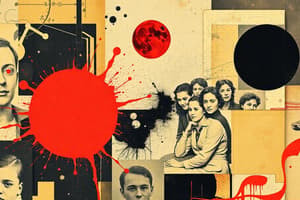Podcast
Questions and Answers
Which group of elements are known as halogens?
Which group of elements are known as halogens?
- Group 7 elements (correct)
- Group 1 elements
- Alkali metals
- Group 0 elements
What is the color of fluorine, one of the halogens?
What is the color of fluorine, one of the halogens?
- Green
- Brown
- Gray
- Yellow (correct)
Which element is known as an antiseptic and has saved millions of lives?
Which element is known as an antiseptic and has saved millions of lives?
- Bromine
- Astatine
- Iodine (correct)
- Chlorine
What happens to the melting and boiling points as you go down the halogen group?
What happens to the melting and boiling points as you go down the halogen group?
What happens to the reactivity as you go down the halogen group?
What happens to the reactivity as you go down the halogen group?
When a halogen gains an electron to form a one minus ion, what is it called?
When a halogen gains an electron to form a one minus ion, what is it called?
Which group of elements are known as noble gases?
Which group of elements are known as noble gases?
What is the characteristic property of noble gases?
What is the characteristic property of noble gases?
What happens to the boiling point of noble gases as you go down the group?
What happens to the boiling point of noble gases as you go down the group?
What type of bond do halogens form with non-metals like hydrogen or carbon?
What type of bond do halogens form with non-metals like hydrogen or carbon?
Study Notes
Halogens
- The halogens are a group of elements in the periodic table, known for their reactivity.
- Fluorine, chlorine, bromine, iodine, and astatine are the halogens.
- Fluorine is a pale yellow gas.
- Chlorine is a greenish-yellow gas.
- Bromine is a reddish-brown liquid.
- Iodine is a dark grey solid.
- Astatine is a radioactive solid.
Halogen Properties
- Halogens are highly reactive non-metals.
- The melting and boiling points of halogens increase as you go down the group.
- This is because the size of the atom increases, leading to stronger intermolecular forces.
- The reactivity of halogens decreases as you go down the group.
- This is because it becomes harder to gain an electron as the atomic radius increases.
Halogens and Antiseptics
- Chlorine is used to purify water and in bleach.
- Iodine is an antiseptic and has saved millions of lives.
Noble Gases
- The noble gases are a group of elements in the periodic table that are very unreactive.
- Helium, neon, argon, krypton, xenon, and radon are the noble gases.
- Noble gases are colorless, odorless, and tasteless at room temperature.
- They are found in trace amounts in the atmosphere.
- They are characterized by their lack of reactivity.
- Their full outer shell of electrons makes them very stable.
- They exist as single atoms and do not form molecules.
- The boiling point of noble gases increases as you go down the group.
- This is because the strength of the London dispersion forces increases with increasing atomic size.
Halogen Bonding
- Halogens form covalent bonds with non-metals.
- These bonds are strong and stable.
- Halogens are often used as a part of functional groups in organic compounds.
Halide Ions
- A halide ion is a halogen atom that has gained one electron.
- This gives the ion a negative one charge (-1).
- The halogen ion is named after its parent element but with an "-ide" suffix.
- For example; fluorine becomes fluoride.
Studying That Suits You
Use AI to generate personalized quizzes and flashcards to suit your learning preferences.
Description
Test your knowledge about the properties and trends of group seven elements (halogens) and group zero elements (noble gases). Learn about the characteristics of fluorine, chlorine, bromine, iodine, and other noble gases.




